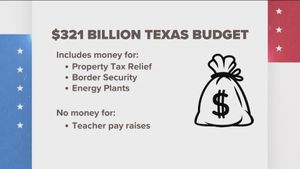Australia's economic future appears poised for significant shifts as experts predict the Reserve Bank of Australia (RBA) will initiate interest rate cuts starting as early as February 2025. With inflation cooling to 2.4%, the groundwork is being laid for adjustments to monetary policy aimed at fostering consumer confidence and economic growth.
Leading economist Paul Bloxham, chief economist for HSBC Australia, emphasizes the importance of these upcoming cuts. Ranked as the most accurate economic forecaster by The Australian Financial Review, Bloxham affirms, "We expect the RBA to cut the cash rate by 25 basis points in February." His insights echo sentiments across the financial sector as stakeholders brace for these anticipated changes.
This downward trend is largely driven by recent data from the Australian Bureau of Statistics, which recorded inflation at its lowest level since March 2021. Such figures have led to widespread belief among market participants about the likelihood of cuts, with traders pricing in nearly a 95% chance of the RBA reducing the cash rate during its February 18 meeting.
The major banks are taking pre-emptive measures by adjusting their mortgage rates to align with the shifting market expectations. NAB recently became the first major bank to lower fixed-interest mortgage rates, cutting rates up to 0.30 percentage points. NAB chief economist Alan Oster noted, "The Q4 CPI confirms inflation has moderated more quickly than the RBA expected and sets up for what seems to be the most likely starting point for gradual easing of interest rates."
With many homeowners eagerly awaiting relief from higher borrowing costs, the cuts signal more than just adjustments to rates—they represent pivotal changes for Australian consumers still grappling with the aftereffects of elevated cash rates. Jessica Amir, market strategist at trading platform moomoo, elaborates on the potential of the RBA's actions, stating, "Banks traditionally do well when interest rates are higher; it theoretically means they’re earning more money." This starkly highlights the delicate balance banks must maintain as the rate horizon changes.
Looking beyond immediate rate cuts, analysts are examining how these changes will affect the banks' profit margins. J.P. Morgan estimates anticipate notable impacts, predicting margins for banks like ANZ and Westpac will contract by approximately 4.8 and 4.7 basis points, respectively, following any RBA decisions. Nathan Zaia, equity analyst at Morningstar, suggested, "There are many moving parts - sure [if there is a rate cut], then margins come down, but banks are pricing both sides of the balance sheet to make decent margins, so they’ll respond accordingly." This analysis reflects concerns about the long-term profitability of major banks amid fluctuatings interest rates.
While market confidence remains cautious, continued discussions about economic resilience and potential bank performance keep stakeholders engaged. The current financial environment shows signs of being conducive to changes, as superannuation funds increase their investments, pushing major banks to high valuations. Although pressures might mount due to lower rates, the overall flexibility of banks could mitigate these risks.
The RBA's anticipated decisions come at a time when Australia is grappling with long-term financial consequences from rising interest rates over the past few years. An increasingly competitive banking environment could also significantly impact market dynamics, as seen during NAB's recent rate cuts attracting attention from borrowers. Observing how other banks might respond to NAB's lead will be pivotal for consumers.
Financial observers remain eager to see how the RBA's moves might shape mortgage offering strategies and overall consumer behavior. If the trend continues as predicted, it should enthuse many homeowners, particularly those who have been awaiting a reprieve from what has felt like unrelenting economic pressure.
Moving forward, the environment will require adaptability and strategic foresight as all banks navigate the potential for changing cash rates and their cascading effects on the market. For consumers, keeping abreast of these developments will likely prove integral as they make decisions about managing their finances.
It remains to be seen how long these anticipated interest rate cuts will stabilize the market and how they will redefine the financial landscapes for both consumers and banks. Nevertheless, as February approaches and the RBA convenes, the collective eyes of the nation will be fixed on the Board’s actions, reflecting hopes for economic recovery and renewed consumer confidence.



